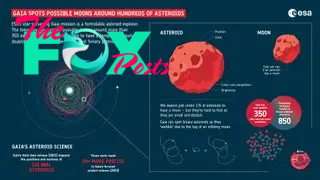Science
Over 350 asteroids have hidden moons, Gaia space telescope finds
The European Space Agency's (ESA) Gaia space telescope has already proven itself invaluable in tracking billions of stars in the Milky Way, but now it has proved its worth with much smaller bodies, much closer to home.
The Gaia mission has spotted potential moons orbiting over 350 asteroids that were previously predicted to be singletons. Gaia had already been investigating known asteroid binaries, confirming they have companions, but this breakthrough shows the star surveyor is capable of conducting "blind searches" for completely new asteroid-moon partnerships.
If the new observations are confirmed, these 352 binaries will almost double the number of known binary asteroid systems in the solar system.
"Binary asteroids are difficult to find as they are mostly so small and far away from us," Luana Liberato, leader of the team behind the discovery and researcher at the Observatoire de la Côte d’Azur, said in a statement. "Despite us expecting just under one-sixth of asteroids to have a companion, so far, we have only found 500 of the one billion known asteroids to be in binary systems.
"But this discovery shows that there are many asteroid moons out there just waiting to be found."
RELATED: Gaia spacecraft reveals 'goldmine' of over 500,000 undiscovered stars

Asteroids are the remains of the material that first formed the sun and then birthed the planets of the solar system over 4.6 billion years ago. They are mainly located in the main asteroid belt between Mars and Jupiter, thus receiving little radiation from the sun, which means this early solar system material is mostly "unspoiled" in asteroids.
-

 Science1d ago
Science1d agoInside Capitol Hill’s Latest UFO Hearings
-

 Science1d ago
Science1d agoYou Won’t Want to Miss the Leonid Meteor Shower. Here’s How and When You Can See It
-

 Science2d ago
Science2d agoHere’s What Trump’s Win Means for NASA
-

 Science5d ago
Science5d agoWhy Risky Wildfire Zones Have Been Increasing Around the World
-

 Science6d ago
Science6d agoIt’s Time to Redefine What a Megafire Is in the Climate Change Era
-

 Science1w ago
Science1w ago4 Astronauts Return to Earth After Being Delayed by Boeing’s Capsule Trouble and Hurricane Milton
-

 Science1w ago
Science1w agoThe Elegance and Awkwardness of NASA’s New Moon Suit, Designed by Axiom and Prada
-

 Science1w ago
Science1w agoSpaceX Launches Its Mega Starship Rocket. This Time, Mechanical Arms Catch It at Landing


























